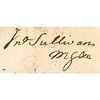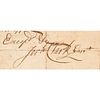1778 Continental Army Gen. JOHN SULLIVAN Document Captured British Ship Supplies
Lot 78
Categories
Estimate:
$2,400 - $3,200
Absentee vs Live bid
Two ways to bid:
- Leave a max absentee bid and the platform will bid on your behalf up to your maximum bid during the live auction.
- Bid live during the auction and your bids will be submitted real-time to the auctioneer.
Bid Increments
| Price | Bid Increment |
|---|---|
| $0 | $10 |
| $200 | $20 |
| $300 | $25 |
| $500 | $50 |
| $1,000 | $100 |
| $2,000 | $200 |
| $3,000 | $250 |
| $5,000 | $500 |
| $10,000 | $1,000 |
| $20,000 | $2,000 |
| $30,000 | $2,500 |
| $50,000 | $5,000 |
| $100,000 | $10,000 |
| $200,000 | $20,000 |
| $300,000 | $25,000 |
| $500,000 | $50,000 |
About Auction
By Early American History Auctions
Mar 20, 2021
Set Reminder
2021-03-20 12:00:00
2021-03-20 12:00:00
America/New_York
Bidsquare
Bidsquare : Autographs-Colonial-Political-Americana
https://www.bidsquare.com/auctions/early-american-history-auctions/autographs-colonial-political-americana-6509
330 Lots of Rare, Historic Autographs, Americana, Civil War Era, George Washington, Abraham Lincoln, Slavery & Black History, Revolutionary War Era, Colonial America, Federal Period, War of 1812, Colonial Currency, Indian Peace Medals & more... Early American History Auctions auctions@earlyamerican.com
330 Lots of Rare, Historic Autographs, Americana, Civil War Era, George Washington, Abraham Lincoln, Slavery & Black History, Revolutionary War Era, Colonial America, Federal Period, War of 1812, Colonial Currency, Indian Peace Medals & more... Early American History Auctions auctions@earlyamerican.com
- Lot Description
Autographs
Major General John Sullivan Revolutionary War Continental Army Signed Expense Document
for Sailing the Captured Prize British Galley "Pigott"
Which was Named for the British Commander at Rhode Island
Sir Robert Pigott, Sailing from Providence, Rhode Island to Stonington, Connecticut
Major General JOHN SULLIVAN (1740-1795). American Revolution War Continental Army Major General under George Washington, captured at Long Island and exchanged, he later Wintered at Valley Forge, and was abandoned by D'Estaing to face the British at Newport, Rhode Island, Delegate in the Continental Congress; 3rd Governor (or "President") of New Hampshire, and appointed by Washington as First United States Federal Judge for NH.
December 12, 1778-Dated Revolutionary War Period, Manuscript Document Signed, "Jno Sullivan MGnl" (Major General), measuring 6" x 10.25", 1 page, at Head Quarters Providence, (RI), Fine. Folds, some moderate tone, old tape repair to the bottom edge, otherwise boldly written in rich brown ink and fully readable with full dates and having a clear bold signature, "Jno Sullivan MGnl" towards the lower portion of the page. This historic Document specifically relates to the historic Captured British (Ship) "Pigott," a Galley in October of 1778. About October 22, 1778 at the British Commander Major General Sir Robert Pigott, 2nd Baronet, who commanded the left flank of the British assault in the Battle of Bunker Hill. Pigot was placed in command in Rhode Island and in the Battle of Rhode Island he fought with 3,000 men against 5,000 men under American Major General John Sullivan. Pigot surrendered his command to General Prescott, under the command of Major General John Sullivan. However, the British galley "Pigott" was left in defence of the east channel and mouth of the Providence river. Silas Talbot fitted out the American ship "Hawk" in Providence with 60 men to capture the galley "Pigott." In the fog at midnight they attacked the galley with the "Hawk's" eight 12-pounder cannon. The surprised crew and commander, Lieut. Dunlop, of the Pigott were soon overwhelmed, the ship fastened with grappling hooks and before dawn their prize was moored in a friendly haven. This Invoice and Receipt were in payment for the expenses and pilot for then sailing in transport the galley "Pigott" to Stonington, Connecticut the next day.
At the entry of France into the American War of Independence in 1778, D'Estaing left Toulon in command of a fleet of twelve ships of the line and four frigates. He intended to assist the American colonies against Great Britain. In cooperation with the American Generals including John Sullivan, d'Estaing planned an attack on Newport, Rhode Island, preparatory to which he compelled the British to destroy some war vessels that were in the harbor. Before the concerted attack could take place, he put to sea against the British fleet, which was under Admiral Howe. Owing to a violent storm, which arose suddenly and compelled the two fleets to separate before engaging in battle, many of his vessels were so shattered that he found it necessary to put into Boston for repairs. Being an Order to paymaster Benjamin Steele to in part:
"To Benjamin Steele Esquire, Paymaster Genl. of the Army in the State of Rhode Island -- Sir Pay Captn. Clark & Officers Eighty three pounds seven shillings and six pence for their Expences [sic] to & from Stonington and during their stay there as specified in the annexed Abstract and this shall be your Sufficient warrant -- Given at Head Quarters Providence this 12th day of Decr. 1778 --- By his honor's Command -- (Signed) "Jno Sullivan MGnl." Noted below as being in receipt for the payment at Providence: 17th Dec. 1778 (Signed) Jerh. Clark, Capt.
On the verso is the expense account in question to:
"The United States..... for Sundry Expenses for Self & Officers from Providence to Stonington & During our Stay there the feeding and care of horses as well as, "Cash paid Candles & Nails for the use of the Piggot Galley..." The Galley was a British Ship captured on Oct 28, 1778 by Capt. Silas Talbot, then commanding the "Hawk". The account also notes 14 Shillings 8 pence paid, "...To Cash pd Wm Card for Pilotage...". Docket reads: "Jer. Clark Capt. Guard Ship his Expenses to Stonington - 277 Dollrs 66/72 No. 118-"
Records show on November 3, 1778, "We the Subscribers, the Officers & Crew of the Sloop Hawk do by the presents appoint Major Silas Talbot to be our Sole Agent in a Voluntary Cruize in the said Sloop in which we captured the Piggott Galley belonging...". The Ship ended up at Newport Harbor (following the British evacuation) and was utilized as a salvage vessel for the shipwrecks left by the British following their occupation of the town. The clearing of wrecks was likely hastened by the imminent arrival of the French Army under Rochambeau that would later join George Washington's forces at Yorktown in 1781. A remarkable original Document, nicely signed by Major General Jon Sullivan in the wake of the Battle of Rhode Island directly connected to the factual account of the captured British ship named after their Commanding General at Providence.
Sir Robert Pigot, 2nd Baronet (20 September 1720 - 1 August 1796) was a British Army officer during the American Revolutionary War.
Robert Pigot was born in London, England in 1720. His two brothers were George Pigot, 1st Baron Pigot, Governor of Madras, India and Admiral Hugh Pigot, Commander-in-Chief of the West Indies fleet.
In 1758 Pigot was Major in the 10th Regiment of Foot. In 1764 he was Lieutenant Colonel. From 1769 to 1775 he was the commander of the 38th Regiment of Foot. He also served as a Member of Parliament for Wallingford from 1768 to 1772. He was appointed Warden of the Mint from August, 1771 until his death.
On 17 June 1775 he commanded the left flank of the British assault in the Battle of Bunker Hill. On 9 July he was Colonel in the 55th Regiment of Foot. He was promoted to the permanent grade of Colonel for his bravery in the Battle of Bunker Hill.
Pigot was made a Major General in 1777. Pigot was placed in command in Rhode Island and made a Lieutenant General in 1782. In the Battle of Rhode Island he fought with 3,000 men against 5,000 men under General John Sullivan. He inherited the baronetcy of his older brother Lord George Pigot (it had been created with special remainder) and the Patshull Hall estate in 1777. He was also left, with his brother Hugh and his sister Margaret (Fisher), the Pigot Diamond which was sold by Act of Parliament in a lottery. On 8 February he resigned and died 1 August 1796 in Stafford, England.
Jean Baptiste Charles Henri Hector, Comte d'Estaing (24 November 1729 - 28 April 1794) was a French general and admiral. He began his service as a soldier in the War of the Austrian Succession, briefly spending time as a prisoner of war of the British during the Seven Years' War. Naval exploits during the latter war prompted him to change branches of service, and he transferred to the French Navy.
Following France's entry into the American War of Independence in 1778, d'Estaing led a fleet to aid the American rebels. He participated in a failed Franco-American siege of Newport, Rhode Island in 1778 and the equally unsuccessful 1779 Siege of Savannah. He did have success in the Caribbean before returning to France in 1780. His difficulties working with American counterparts are cited among the reasons these operations in North America failed.
In cooperation with the American Generals, d'Estaing planned an attack on Newport, Rhode Island, preparatory to which he compelled the British to destroy some war vessels that were in the harbor. Before the concerted attack could take place, he put to sea against the British fleet, which was under Admiral Howe. Owing to a violent storm, which arose suddenly and compelled the two fleets to separate before engaging in battle, many of his vessels were so shattered that he found it necessary to put into Boston for repairs. He sailed for the West Indies on November 4, 1778.
Although d'Estaing sympathized with revolutionaries during the French Revolution, he held a personal loyalty to the French Royal family. Because of this he came under suspicion, and was executed by guillotine in the Reign of Terror.
Our Auction Contents:
Black History & Slavery: (Lots 1 - 63)
Abraham Lincoln Related: (Lots 64 - 74)
Historic Autographs: (Lots 75 - 235)
Colonial America: (Lots 236 - 261)
Revolutionary War: (Lots 262 - 304)
George Washington Related: (Lots 305 - 306)
Early American Guns & Weapons: (Lots 307 - 318) - Shipping Info
-
Early American provides in-house worldwide shipping. Please contact us directly if you have questions about your specific shipping requirements.
-
- Buyer's Premium



 EUR
EUR CAD
CAD AUD
AUD GBP
GBP MXN
MXN HKD
HKD CNY
CNY MYR
MYR SEK
SEK SGD
SGD CHF
CHF THB
THB

















